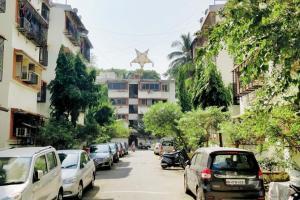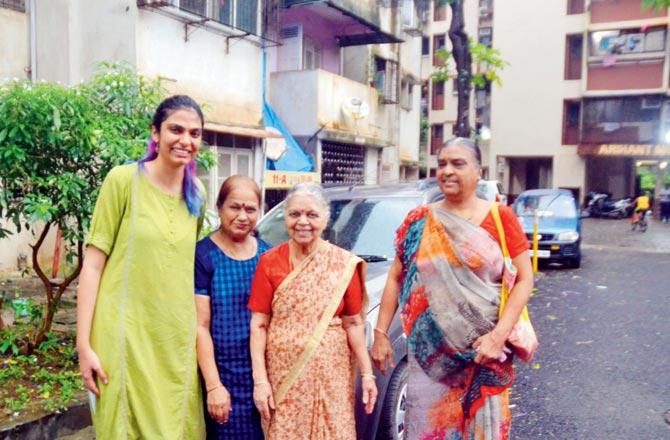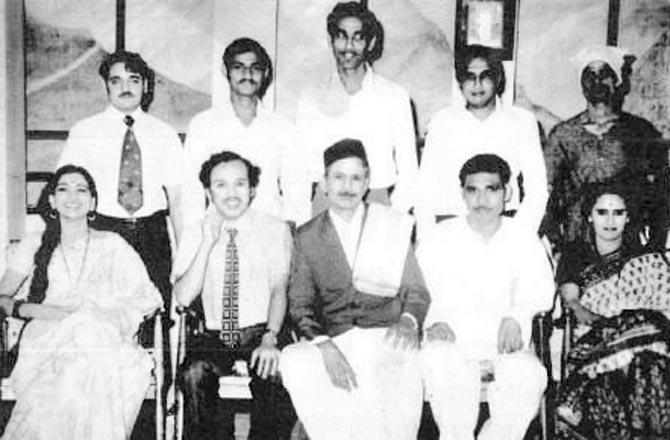Architect Apoorva Sharma charts the origin and evolution of Mumbai's cooperative housing societies which, like chawls, have for long shaped urban life and exchanges

A photograph of Yoganand Society taken by architect-researcher Apoorva Sharma, earlier this year
 Let our dreams of brick and stone and mortar, cement and steel come true. By building housing colonies and townships, we can raise our standards of living... thus there will truly be a richer fuller life for all of us, and for the coming generations. These are the closing lines of the Films Division documentary (Search for Shelter, 1950) which focused on the Bombay government's efforts to build new townships on a cooperative basis. The black-n-white nine-minute English film, made three years after Independence, advocated rapid construction projects as a cure-all for urban housing in Mumbai where the displaced homeless converged for jobs.
Let our dreams of brick and stone and mortar, cement and steel come true. By building housing colonies and townships, we can raise our standards of living... thus there will truly be a richer fuller life for all of us, and for the coming generations. These are the closing lines of the Films Division documentary (Search for Shelter, 1950) which focused on the Bombay government's efforts to build new townships on a cooperative basis. The black-n-white nine-minute English film, made three years after Independence, advocated rapid construction projects as a cure-all for urban housing in Mumbai where the displaced homeless converged for jobs.
ADVERTISEMENT
In 2019, 72 years after Independence, a 27-year-old architect-researcher Apoorva Sharma points at the political incorrectness of the film's worldview, in her study titled Stories of Suburban Mumbai's Co-operative Housing Societies, done under the aegis of Mumbai's School of Environment and Architecture (SEA). Sharma, who taught a module on Repair And Retrofit (based on embedded retrofit practices in five Mumbai building types) at SEA, finds the 'richer-fuller-life' theory funny at two levels: first, despite the 60,000 societies in Greater Mumbai and around (Thane, Palghar and Navi Mumbai) a large sprawling population is in slums or homeless; second, a feverish congestion of residential co-operatives is not necessarily perceived as an eco-friendly option for a crowded metropolis. Sharma has dealt with a range of housing models in her examination of emerging
cities like Vishakhapatnam and Vijayawada. As a Fellow of the Indian Institute for Human Settlements in Bangalore, she zeroed in on "Houselessness in Shivajinagar."

Sharma with residents of Shree Mohan Society in Borivli. Pic/Datta Kumbhar
Sharma celebrates human influences like trust, tolerance, kinship, collective decision-making and mutual respect that contribute to the making of the co-operative model, but she is also attentive to the conflicts and 'othering' it lends itself to. That's precisely why her study of 15 key cooperatives is not purely academic, but resting on a mix of personal narratives, government policy, Bombay Rent and Cooperation Acts, city survey records, Mumbai Development Plan and urban architecture journals. Pages from souvenir publications of vintage co-operatives add a new dimension to the study, especially the chapter on Yoganand society's tryst with Marathi theatre. The energy that has gone into the staging of over 60 plays in five decades is exemplary.
There is also a childhood story behind Sharma's delayering of Mumbai's cooperatives. She was born-raised in a Punjabi family in Chandigarh. After the initial years in Kashmir, her father (banker) was posted in Mumbai, which was wholeheartedly welcomed because "my working mom and I wanted life in an open-minded progressive city where girls could wear shorts without being mocked at." As a five-year-old, she rejoiced in the society garden and loved the treks led by a retired army uncle. The singing class of a south-Indian aunty, Rangoli contests, Fathers' Cooking Day, and Ganesh festivities made a great life—all under the tutelage of Mala Towers in Lokhandwala Complex, Andheri.

Yoganand society's theatre repertoire: A moment from the 1970s, sourced from the golden jubilee souvenir publication
"I adored the extended family; my idea of a cosmopolitan Mumbai also firmed up here," she recalls. Little did she know that she was soon going to relocate to Chandigarh and Delhi where life would be contained in bungalows. Her next brush with Mumbai's cooperative came in 2018 as the research associate at SEA. As part of the second stint, which ends with the August release of her study on cooperatives, she has lived in Borivli's Shree Mohan society, part of the larger Govind Nagar neighbourhood where she got first-hand access to residents and committee members of a large CHS layout. As an architect, she is profoundly interested in the behavioural impact of neatly designed neighbourhoods on the quality of life—do community spaces ultimately lead to togetherness, or do they create a forced sense of inseparability? She has studied the physical form and aesthetic of the 1BHK against the backdrop of newer apartments with glazed marble porticos, large glass windows, lobbies and security guards.
Sharma dwells on Mumbai's pioneering housing societies which paved the way for a sturdy co-operative legal framework with defined processes and formatted negotiations. Just as the large Sindhi population, homeless after the Partition, set up Shyam Niwas and Nanak Niwas in Cumbala Hill, similarly Parsis, Catholics and Saraswat Brahmins realised the worth of partnership to seek land and loan subsidies, which was also the thrust of the country's First Five Year Plan. Around this time, the Bombay city stretched to include the Salsette Island, which signalled a large available stretch of small settlements, marshy farm patches, orchards, cowsheds, Buddhist caves and old Portugese churches along the Western line.
The city's northward suburbanisation and availability of low-cost land went hand-in-hand with the rise of the middle class desire of shared ownership of land. Adventurists like Baburao Paranjpe and Dr Balwant Patil, who were nowhere connected with the building construction business, decided to take the plunge and showed the willingness to learn the legalese of co-operation. These early promoters were involved in the actual purchase of bricks-plaster-wood needed to raise a residential structure; they built roads, sewage lines and support infrastructure (Don Bosco school in Borivli and Parle College in Vile Parle are two examples) to make the CHS model functional. They sought the masons, plumbers and site labourers. They went beyond their formal mandate with regard to land use, pooling of resources, development of skill sets, acceptance of technology and the sheer gumption to build buildings with no prior experience. As the folklore goes, 'Grihdaata' Baburao Panrajpe spared his early morning hours to any and every visitor, be it a young couple seeking an interest-free loan or society members trapped in a legal battle with adjoining slum dwellers.
It is interesting to note that one cooperative model inspired the other. Paranjpe was inspired by Rao Bahadur Shripad Subbarao Talmaki (a lawyer) who popularised the value of shared ownership in banking as well as housing for the Chritrapur Saraswats even before Independence. Paranjpe read about and learnt from the Saraswat kinship, after which he worked towards rationalising cooperative housing societies for Maharashtrian Brahmins in Vile Parle in the fifties. After his success of Parleshwar and Vishnu Prasad, he followed the 'chawl' typology in Ramanand, Datta-Ramanand and Vijay Nagar societies which catered to teachers, who were not among the better-paid workforces.
The study acknowledges the fact that while the early pioneers subscribed to caste-community based housing projects, which do not strictly adhere to India's secular ideals, their work cannot be belittled in the context of India's large homeless lower-middle class. The early cooperatives (even those formed along parochial lines) were a rare ray of hope for subsistence families who could never have otherwise owned an independent flat with its sovereign toilet. Sharma demonstrates rare maturity in her appreciation of the caste realities that determined (and still do) real estate negotiations in India's largest megapolis. As per the Maharashtra Cooperative Housing Societies Act, 1960, a society is not allowed to deny any person the right to book a flat, based on religion, caste or gender identity. However, as Sharma's interviewees admit, the spirit of egalitarianism is notional than practical. Residents have shared the unwritten-unspoken ways in which 'societies' can articulate their disapproval of an unwanted member—either a non-vegetarian or a pet owner or a gender neutral.
Community space has attained a geo-strategic dimension as Mumbai's older cooperative societies —with adjoining gardens, temples, playgrounds, walking strips—are being offered for 'redevelopment.' It is feared that the new Mumbai of plush towers, gated townships and gaming zones may not accommodate the modest CHS with its low stake potluck parties and summer sports. Sharma intends to study that too.
Sumedha Raikar-Mhatre is a culture columnist in search of the sub-text. You can reach her at sumedha.raikar@gmail.com
Catch up on all the latest Crime, National, International and Hatke news here. Also download the new mid-day Android and iOS apps to get latest updates
 Subscribe today by clicking the link and stay updated with the latest news!" Click here!
Subscribe today by clicking the link and stay updated with the latest news!" Click here!






